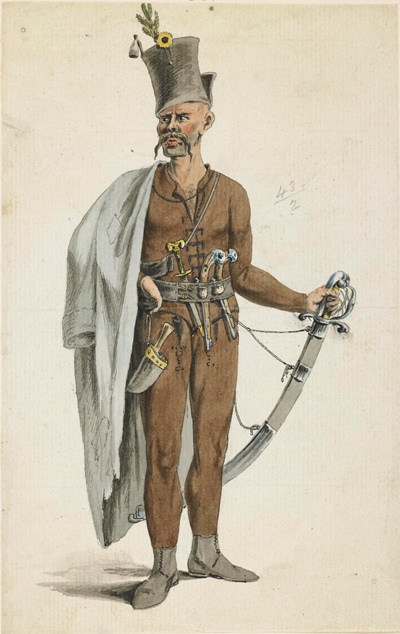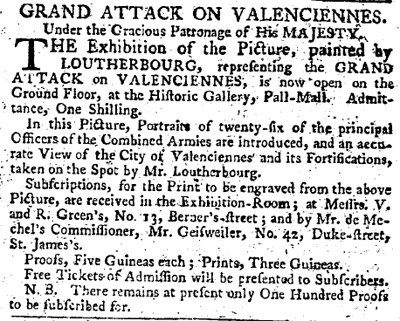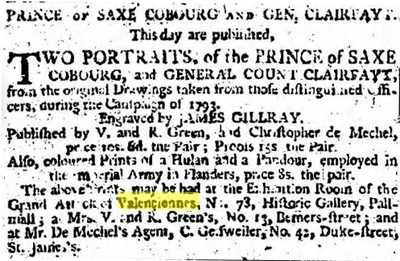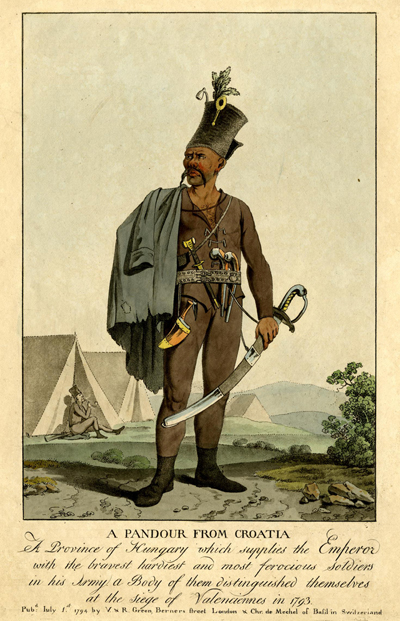A Pandour from Croatia*
This is one of four prints by Gillray that were sold at the exhibition of the painting of The Grand Attack at Valenciennes by Philip James de Loutherbourg in celebration of the short-lived victory over French revolutionaries by the "combined forces" under the command of the Duke of York on July 25, 1793. Gillray had accompanied de Loutherbourg on his journey to France to research the painting, making preparatory sketches of the principal officers and the cannons, uniforms, pack horses, and other military equipment that would likely appear in a painting of the battle. In the meantime de Louthbourg sketched the battle landscape and surrounding countryside. While chosen for his ability to make swift and accurate sketches under less than optimum conditions, Gillray often went well beyond that description (when troop movements allowed) to create impressive portraits of officers such as Major Congreve that display Gillray's considerable powers as a portraitist.
Part of the light infantry of the Prince of Saxe-Coburg, this Pandour from Croatia must have caught Gillray's eye, even though he was not an officer, because of his sheer exoticism—so different from the familiar British troops he would have been used to seeing. The Pandours were heavily armed and noted for their ferocity as soldiers. Gillray's initial sketch, immediately below, appears to have made from life while the Pandour posed for the occasion, probably in September 1793, at roughly the same time that Gillray drew The Prince of Saxe-Coburg.

© Trustees of the British Museum
The Pandour stands a bit stiffly and self-consciously, his left arm jutting out to hold his huge Hungarian sabre which would otherwise trail on the ground. His military great coat is draped over his right shoulder, his right hand just visible at his waist. It is an impressive piece of work, especially during wartime.
Like all of the drawings that Gillray made on his trip to Valenciennes, this sketch was almost certainly made without thought of later production. And not suprisingly, the initial advertisements for the grand exhibition of de Loutherbourg's painting make no mention of any prints beyond that of the Grand Attack itself.

London St. James's Chronicle
[June 3, 1794]
It is not until mid-July that portraits of The Prince of Saxe-Coburg and General Count Clairfayt and the "Coloured Prints of a Hulan and a Pandour" are advertised as part of the exhibition. So sometime after June 3rd, the publishers, Valentine and Rupert Green and Christian von Mechel must have realized that they could make some additional profit from the captive audience attending the exhibition of de Loutherbourg's painting by selling some smaller prints related to the Grand Attack. And if the publication dates on the actual prints is a reliable indicator, they decided that the portraits of the other commanders of the troops (both listed as published June 23rd) would be the initial offering, before later adding the Pandour annd Hulan (listed as published July 1st).

London Times
[July 16, 1794]
Not surprisingly given his perfectionism, Gillray chose not simply to trace his quite serviceable sketch of the Pandour, but to redraw and improve the whole. He eliminated the awkward left arm by having the Pandour hold the (now shortened) sword by the sheath in front of him. The distracting right hand of the sketch is now completely hidden beneath the coat. The coat itself is also shortened and raised to give greater prominence to the Pandur fighting knife. His legs are now farther apart and his headdress tilted back giving the whole figure a more classical and confident appearance. Finally, Gillray has added a backgound with a series of tents and a smoking Pandour making it clear that the portrait is taken at the army camp during a lull between battles.

© Trustees of the British Museum
* Many thanks to Tim Clayton for alerting me to the existence of this print and its companion, A Hulan from Gallicia.
Sources and Reading
- Commentary from the British Museum on A Pandour from Croatia.
- "Pandur," Wikipedia
- "Trenck's Pandurs," Wikipedia
Comments & Corrections
NOTE: Comments and/or corrections are always appreciated. To make that easier, I have included a form below that you can use. I promise never to share any of the info provided without your express permission.